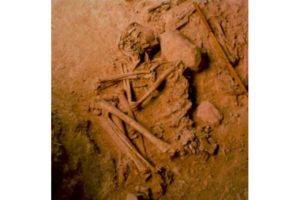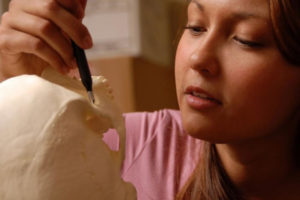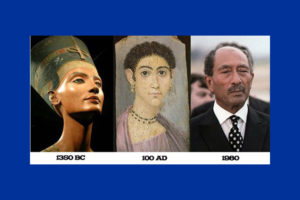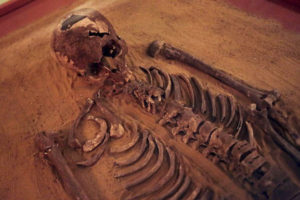November 2014. A genetic study on skin-color causing genes has confirmed that “South Asians and Europeans share identity by descent”—in other words, that the lighter skin of many inhabitants of northern Indian is the result of European ancestry.

Above: Aishwarya Rai of India competes in the swimsuit parade during the finals for Miss World 1994.
The study, officially titled “The Light Skin Allele of Slc24a5 in South Asians and Europeans Shares Identity by Descent,” published in the November 7, 2013 edition of the journal PLOS Genetics, was typically misrepresented in the controlled media coverage as simply a “shared gene” (see for example the NBC News coverage here).
However, the original study, which can be found online at the PLOS website here, specifically talks about common genetic descent, not just “sharing” a gene, as it states: “By studying the variation of SLC24A5 sequences among a diverse set of individuals, we show that the light skin associated allele in South Asians is identical by descent to that found in Europeans.”
It has long been known that India was subjected to an invasion by “Aryans” (a tribe of Indo-Europeans who called themselves by that name, meaning that “Aryan” is actually a cultural term rather than a racial one) several thousand years ago.
It was these European “Aryans” who set up the caste system, a form of racial segregation, and enacted the laws still widely practiced to this day in India, of social class distinctions, in an attempt to prevent mixing with the lowest—and darkest—classes of Indians, the Sudra, or the “untouchables.”
The Aryan invasion of India was confirmed by Y Chromosome DNA analysis many years ago (see “History of Ancient Indian Conquest Told in Modern Genes, Experts Say,” Newsday, May 26, 1999).
That report, based on a study conducted by researchers from the University of Utah and Andhra Pradesh University in India, found that the genetic profile of India “vividly reflect a historic event, or events that occurred 3,000 or 4,000 years ago. The gene patterns are consistent with a historical scenario in which invading Caucasoids—primarily males—established the caste system and occupied the highest positions, placing the indigenous population, who were more similar to Asians, in lower caste positions.”
One of the study authors, geneticist Lynn Jorde of the University of Utah, went on to be quoted as follows: “[T]here was a group of males with European affinities who were largely responsible for this invasion 3,000 or 4,000 years ago.”
The new PLOS-published research paper confirmed the previous theory and the study.
“A study of extended haplotype homozygosity in HapMap populations estimated that the most intense signals of selection detected in European and East Asian populations are found in haplotypes which extend 0.52 cM on average in length. Assuming a star-shaped genealogy and a generation time of 25 years, the authors dated the peak of these signals to ~6.6 KYA,” the new study paper said. (KYA=thousands of years ago, i.e. 6.6 KYA is 4000 BC.)
“They also observed that the second-longest haplotype (1.15 cM) in Europe includes SLC24A5, where rs1426654-A was found to be fixed. Using the same formula used by Voight to date the average peaks of selection signals in Europe and East Asia, the selective sweep specifically at SLC24A5 in the HapMap European sample can be dated to ~3 KYA.”
In other words, the dating of the European-origin allele seems to fit in perfectly with the time of the Indo-European Aryan invasion.

The paper also specifically pointed out the “demographic history” which gave rise to the distribution of the light skin gene: “We have shown that the rs1426654-A allele is widespread in the Indian subcontinent and its complex pattern is a result of combination of processes involving selection and demographic history of populations, influenced by their linguistic and geographic affiliations.”
Original paper citation: Basu Mallick C, Iliescu FM, Möls M, Hill S, Tamang R, et al. (2013) “The Light Skin Allele of SLC24A5 in South Asians and Europeans Shares Identity by Descent.” PLoS Genet 9(11): e1003912. doi:10.1371/journal.pgen.1003912








Great article, and i have a Question, iam searching for some study books (not articles) which defense the socalled Indo Aryan Invasion of india. I see that many books have been written against this theory. Does anyone knows some recommended titels in print or out of print.
Ralph, the book you can review is THE ARYANS, A study of Indo European Origins, V Gordon Childe it’s there on kindle.
Aryans are an exclusive branch from the father branch of three, which turned back to go into Indian Subcontinent eventually. The civilization grew in Central Asia calling themselves Aryans try get o civilize the world. One of their branches were Persians, and likewise empires off three that finally invaded into India at the close of Harappan civ. Then they conquered Northern indis creating small kingdoms. One went large enough to cover Afghanistan, India Burma, Indonesia except Southern India. Empires were Hittites, Mittani, Kushans.
These called themselves Aryans to segregate their origins from locals, Dravids. Which probably meant int their eyes,, mystics or Druids. Caste was established to keep bloodline untouched, as it matter edit then.
Aryans were not of European orgin. Yet Europeans came from same R1a haplogroup M17 marker branch that gave rise to Aryans. No European history refers to Aryans but Indian and Central Asian Vedic books have been understood to refer. There’s been a rush in west by many to call themselves Aryans. This is uninformed. Aryans were only the Central Asians and their offshoots into India.